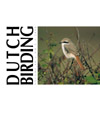Dutch Birding volume 30 (2008) no 5

30 years Dutch Birding, part 4: 1999-2003
This paper describes the fifth five-year period of Dutch Birding and the DBA. This period was characterized by many rarities (especially 2000 and 2003 were top years) and rapid technological developments, which strongly influenced the way birders operated in the field and shared information. Among these developments was the merging of the five pager groups into one group being centrally coordinated, technically supported by the DBA and more closely linked to the Dutch Birding birdline. Other important developments were the strong increase in the number of mobile telephones; several technical improvements in the birdline; the growing affordability, quality and - as a result - popularity of digital photography and 'digiscoping'; and the strong growth in both content and number of visitors of the Dutch Birding website. At the same time, the increase of internet access led to the start of other birding websites and discussion groups. The members of DBA board, editorial board and rarities committee (CDNA) remained more or less the same during this period with only a few changes. The contents of Dutch Birding, with more pages and more photographs than ever before, reflected the growing interest in the identification of many (former) subspecies, resulting in several ground-breaking identification papers and papers documenting and explaining recent taxonomic developments.
New taxa for the Dutch list in this period were (in chronological order): Pygmy Cormorant Phalacrocorax pygmeus (two records) and African Chaffinch Fringilla coelebs africana in 1999; Turkestan Shrike Lanius phoenicuroides and Lesser Kestrel Falco naumanni in 2000; Little Swift Apus affinis and Egyptian Vulture Neophron percnopterus in 2001; Bearded Vulture Gypaetus barbatus (first unmarked/unringed and therefore acceptable bird), Eurasian Pygmy Owl Glaucidium passerinum and Wilson's Storm Petrel Oceanites oceanicus in 2002; and Canvasback Aythya valisineria (currently under review because of wingtag), Audouin's Gull Larus audouinii, Trumpeter Finch Bucanetes githagineus, Blue Rock Thrush Monticola solitarius, Hornemann's Redpoll Carduelis hornemanni hornemanni, Eastern Black Redstart Phoenicurus ochruros phoenicuroides and Western Orphean Warbler Sylvia hortensis in 2003.
Other notable records were, eg, Rufous-tailed Rock Thrush M saxatilis (fourth record), Red-flanked Bluetail Tarsiger cyanurus (third) and Forster's Tern Sterna forsteri (third) in 1999; Franklin's Gull L pipixcan (third), Snowy Owl Bubo scandiacus, two Alpine Accentors Prunella collaris (third and fourth, first since 1986), Grey-headed Woodpecker Picus canus (fourth, first twitchable since 1982), Spanish Sparrow Passer hispaniolensis (second), Black-winged Kite Elanus caeruleus (third), Cinereous Vulture Aegypius monachus (second, first since 1948), Stilt Sandpiper Calidris himantopus (second), Laughing Gull L atricilla (third, concerning 'Atze'), Sharp-tailed Sandpiper C acuminata (fourth), Long-legged Buzzard Buteo rufinus (second, first since 1905), two Isabelline Wheatears Oenanthe isabellina (second and third), Daurian Shrike L isabellinus (third) and a group of up to five Surf Scoters Melanitta perspicillata (only multiple record) in 2000; Dartford Warbler S undata (fourth), a group of 18 Griffon Vultures Gyps fulvus, Arctic Warbler Phylloscopus borealis (second twitchable), Blyth's Reed Warbler Acrocephalus dumetorum (fourth) and Red-flanked Bluetail (fourth) in 2001; Golden Eagle Aquila chrysaetos (first twitchable in 20 years), Steppe Eagle A nipalensis (fourth), 'orange-billed tern' (still unidentified), Franklin's Gull (fourth), Bonelli's Eagle A fasciata (third), Lanceolated Warbler Locustella lanceolata (third), two Pallas's Grasshopper Warblers L certhiola (second and third), Alpine Swift A melba (first long-stayer) and Blyth's Pipit Anthus godlewskii (third) in 2002; and Pygmy Cormorant (fourth), African Chaffinch (second), Eastern Black-eared Wheatear O melanoleuca (third), Forster's Tern (fourth), White-throated Robin Irania gutturalis, Pallas's Grasshopper Warbler (fourth), Daurian Shrike (fourth), two (hardly) twitchable Blyth's Reed Warblers, Dartford Warbler (fifth), 'Central Asian Lesser Whitethroat' S curruca halimodendri/minula and the first truly twitchbale White-headed Long-tailed Bushtits Aegithalos caudatus caudatus - making 2003 a remarkable year for (very) rare subspecies.
At the end of 2003, the number 1 birder (Klaas Eigenhuis) stood at 437 species, only seven ahead of the number 10. The national year list record was set at 339 by Jan Wierda in 2000 (still standing) and the national big day record was set at 187 in May 2003 (also still standing).
G J (Hans) ter Haar, Hollandse Hout 127, 8244 GD Lelystad, Nederland
(hterhaar planet.nl)
planet.nl)
terug






